Calf tennis ball massage
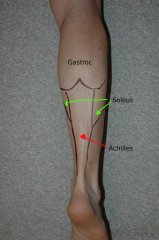 In this part of the series, we’re going to start with the calf muscles. They play a major role in shock absorption as you step onto your foot, provide control and balance as you move over your foot/ankle from double to single leg stance, and assist in propulsion as you push off of your toes at the end of the gait cycle. With that in mind, they are a common source of problems in the lower extremities. Tight calf muscles can lead to problems both in the foot and shin, as well as, up the chain into the knee, hip, and back.
In this part of the series, we’re going to start with the calf muscles. They play a major role in shock absorption as you step onto your foot, provide control and balance as you move over your foot/ankle from double to single leg stance, and assist in propulsion as you push off of your toes at the end of the gait cycle. With that in mind, they are a common source of problems in the lower extremities. Tight calf muscles can lead to problems both in the foot and shin, as well as, up the chain into the knee, hip, and back.
There are three primary muscles in the calf region. To make it easier to locate them, let’s break them up into two layers of muscles.
1) Superficial Muscles
There are two muscles in the top (superficial) layer- the gastroc and the soleus. The gastroc is the easiest and most visible of all the calf muscles- it’s the two bumps that pop out when you step up on your toes. The soleus muscle is underneath the gastroc and lower down the leg (think just below the two muscle bellies (bumps) of the gastroc on either side of the achilles tendon/ or mid-way between the knee and heel). Both of these muscles become the Achilles Tendon which inserts into the back of your heel. The main difference between the two muscles is in how they work. The larger gastroc muscle helps you push off of your toes when the knee is straight versus the soleus muscle which does the same thing while the knee is bent. For example- it is very common for runners to have sore and stiff soleus muscles following a hilly run when they are unable to fully extend the knee and push off going uphill and when the knees are bent and shock absorption is increased coming downhill.
2) Deep Muscles
In the second layer of muscles is your posterior tibialis. This muscle is located deep to both the soleus and gastroc. It runs down the middle of the back of your lower leg before moving towards the inside of the leg and down the tibia. It’s tendon can be felt as it wraps around the inside ankle bone (medial malleolus) and inserts into the arch of your foot. The reason that I want to involve this muscle is that it is frequently involved in plantar fasciitis/heel injuries and is a sight of tendonitis behind the ankle. The post tib helps support the arch and maintain heel position as you step onto your foot. From a muscle action perspective, the post tib plantar flexes the ankle (points the toes down) and inverts the calcaneous (points the toes in towards the midline of the body). As the larger calf muscles fatigue/stiffen, it is very common for the posterior tib to help compensate by helping with push off and toe clearance. The result is frequently the foot swinging through with the arch positioned up towards the sky instead of down towards the ground. The post tib can also be a source of “shin splints” because of this.
Soft Tissue Techniques
What you’ll need: a foam roller and a tennis/trigger point ball.
You might also like
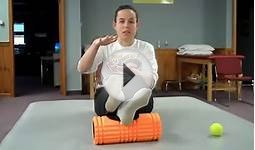

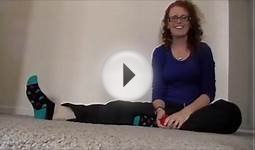
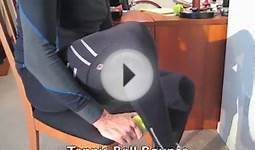
|
Yamuna Save Your Shoulders Kit - Yamuna Gold Ball, 2 "Calf" Balls, Yamuna pump, Yamuna Save Your Shoulders DVD - Manage and Relieve Neck and Shoulder Pain! Sports (Yamuna)
|

|
Massage Blocks - Twin Block Pro - Powerful Trigger Point Therapy for Tension Headaches + Twin Block whole body tool. Health and Beauty (Massage Blocks)
|



 Billie Jean King (née Moffitt; born November 22, 1943) is an American former professional tennis player. She won 12 Grand Slam singles titles, 16 Grand Slam women's doubles titles, and 11 Grand Slam mixed doubles titles. King has been an advocate against sexism in sports and society. She won "The Battle of the Sexes" in 1973, in which she...
Billie Jean King (née Moffitt; born November 22, 1943) is an American former professional tennis player. She won 12 Grand Slam singles titles, 16 Grand Slam women's doubles titles, and 11 Grand Slam mixed doubles titles. King has been an advocate against sexism in sports and society. She won "The Battle of the Sexes" in 1973, in which she...
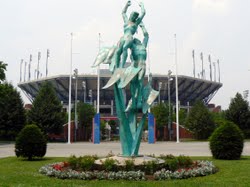 The USTA Billie Jean King National Tennis Center is located in Flushing Meadows Corona Park in the New York City borough of Queens and has been the home of the US Open Grand Slam tennis tournament played every year in August and September. Operated by the United States Tennis Association (USTA) since 1978, the facility has 22 courts inside its...
The USTA Billie Jean King National Tennis Center is located in Flushing Meadows Corona Park in the New York City borough of Queens and has been the home of the US Open Grand Slam tennis tournament played every year in August and September. Operated by the United States Tennis Association (USTA) since 1978, the facility has 22 courts inside its...